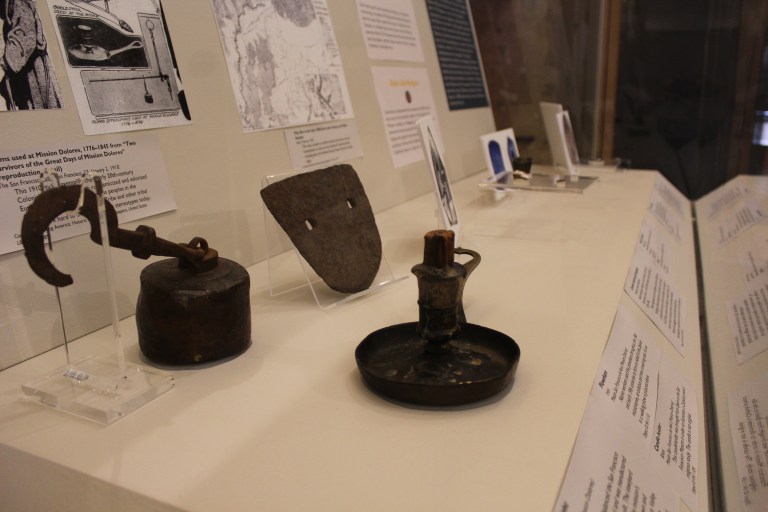Shards of a Chinese vase, a stone mortar and pestle and a brass phoenix button: These artifacts and many more are currently on display in the exhibit “Before Stanford: Founding Communities, Present Pasts,” a collection of artifacts from the Stanford University Archaeology Collections curated by students.
The four-case exhibit was the result of a class, ARCHLGY 134: “Museum Cultures: Material Representation in the Past and Present,” taught by Christina Hodge, academic curator and collections manager. Over a 10-week quarter, students attended lectures and tours to gain background information and then split into groups of three to create the different cases that make up the exhibit.
The display offers an inside look at the lives of three main groups who once lived on the Farm: the Muwekma Ohlone tribe, Spanish colonialists and the workers at Jane and Leland Stanford’s mansion. As a whole, the exhibit emphasizes the role of Stanford’s past in the present and future.
Creating the exhibit
While Hodge curated the introductory case and provided advice, the students designed the layout of the cases, drafted explanatory texts and mounted the artifacts.
The process of finding and displaying the interactions between people at different times in Stanford’s history taught students about everything that goes into creating an exhibit.
“I definitely think about museums differently now — the stuff that has to go into just displaying something,” said student curator Nylah Byrd ’18.
Picking the artifacts for each case required careful thought. After group members established a theme for their case, they looked for artifacts within the Stanford collection that were able to tell a story about the people in their given time period.
Student curator Michelle Kwon ’16 explained how a simple call bell wire from the Stanford mansion represented the relationship between employee and employer at the time it operated.
The wire connected the bells in the house, which gave employees and employers the freedom to communicate with each other despite not being in the same physical space. But Kwon pointed out the irony in the situation: Those working for the Stanfords may have had physical freedom, but they were required to answer calls and could not come and go as they pleased.
Before splitting into groups, all students spoke with an expert in order to understand objects from the Muwekma Ohlone tribe.
According to Hodge, Muwekma Ohlone chairwoman Rosemary Cambra spoke with the class to emphasize “the creativity and persistence of [her] ancestral community, the complexity of their religious traditions and … how important Stanford lands remain to them.”
The talk allowed students to understand not only the significance of each artifact but also the role that the Muwekma Ohlone people have played and continue to play in Stanford’s history.
“When we were creating the exhibit, we really tried to make sure that we didn’t portray the Native American population as something that was only in the past,” Byrd said. “We tried to really make sure that [it was shown that] the society still exists… It’s still present today.”
Kwon also emphasized that the Ohlone are still present today and should be understood and respected. She feels that this understanding has been lacking in the past decades.
Lessons from history
“Before Stanford” showcases not only specific time periods but also the connections between them. Take, for example, the phoenix button in the “Missions and Rancheros” case, which chronicles Spanish colonialism with artifacts from Mission Dolores and the Buenal Rodrigues Adobe, a 19th-century Mexican farmstead. As Hodge explained, there is more to the button than first meets the eye.
“[The button was] made in England for a ruler in Haiti, then traded in California and was almost certainly owned and valued by an indigenous laborer on the Buelna estate in the 1830s,” Hodge said. “This tiny personal item prompts us to recognize the experiences of Native people in early California and the vast dynamics of colonialism and globalization.”
Kwon said researching the interactions between different groups in each time period allowed her to learn more about what makes an interaction between different groups a positive one.
“Being able to be open and understand each other is one of the more fundamental roots that can create cooperation and, again, respect,” Kwon said.
While rooted in the past, material in the “Missions and Rancheros” case may influence future decisions on campus. “Mission and Rancheros” touches on colonialism; a campaign to rename Stanford buildings and streets named after Junipero Serra grew out of controversy surrounding Serra’s role in colonization of the area.
Carson Smith ’19 is a student senator on campus as well as a member of the Native community due to her family ties with the Choctaw Nation of Oklahoma. Smith said that exhibits like “Before Stanford” may help the renaming campaign by calling attention to the injustices done to Native peoples.
“Showing Stanford recognizes this [issue of the Serra buildings], and [that] we have archaeology exhibits that recognize this … could be really helpful,” Smith said.
Smith believes that showcasing history may help combat the argument that Serra’s actions were normal for the time period and therefore not a problem. She said history exhibits that call attention to missionaries’ treatment of Native peoples acknowledge the flaws in the missionaries’ ways despite what their eras may have accepted.
“You can bet that you’ll at least affect a handful of people at the very least, and that’s all you can really ask for and hope that that just snowballs,” Smith said. “You have to start somewhere, right?”
Contact ZaZu Lippert at zazulippert ‘at’ gmail.com.
